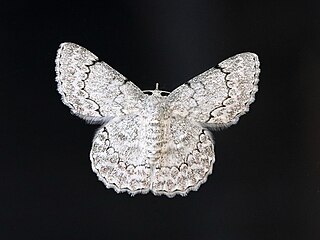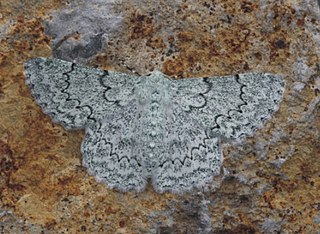
Pingasa is a genus of moths in the family Geometridae first described by Frederic Moore in 1887.

Pingasa chlora, the white looper moth or flower-eating caterpillar, is a species of moth of the family Geometridae first described by Caspar Stoll in 1782. It is found Sundaland, the Philippines, Sulawesi and from the Moluccas to Queensland, Australia.

Pingasa hypoleucaria is a species of moth of the family Geometridae first described by Achille Guenée in 1862. It is found on Réunion and Mauritius.

Pingasa angulifera is a moth of the family Geometridae first described by William Warren in 1896. It is found in Queensland, Australia.
Pingasa aravensis is a moth of the family Geometridae first described by Louis Beethoven Prout in 1916. It is found on Bougainville Island of Papua New Guinea.
Pingasa atropa is a moth of the family Geometridae first described by Louis Beethoven Prout in 1935. It is found on Java.
Pingasa cinerea, the tan-spotted grey, is a moth of the family Geometridae. The species was first described by William Warren in 1894. It is found in the Australian states of New South Wales, Queensland, Tasmania and Victoria.
Pingasa cornivalva is a moth of the family Geometridae first described by Wiltshire in 1982. It is found in Saudi Arabia.
Pingasa crenaria is a moth of the family Geometridae first described by Achille Guenée in 1858. It is found in India and Taiwan.
Pingasa dispensata is a moth of the family Geometridae first described by Francis Walker in 1860. It is found in India, Sulawesi and Africa.
Pingasa elutriata is a moth of the family Geometridae first described by Louis Beethoven Prout in 1916. It is found in northern India.
Pingasa herbuloti is a moth of the family Geometridae first described by Pierre Viette in 1971. It is found on Madagascar.
Pingasa lahayei is a moth of the family Geometridae first described by Charles Oberthür in 1887. It is found in Spain, North Africa and tropical Africa, including the Gambia.
Pingasa manilensis is a moth of the family Geometridae first described by Louis Beethoven Prout in 1916. It is found on the Philippines.
Pingasa meeki is a moth of the family Geometridae first described by William Warren in 1907. It is found on New Guinea.
Pingasa nobilis is a moth of the family Geometridae first described by Louis Beethoven Prout in 1913. It is found in New Guinea and Queensland, Australia.

Pingasa pallidata is a moth of the family Geometridae first described by Joseph de Joannis in 1913. It is found in Eritrea.
Pingasa pauciflavata is a moth of the family Geometridae first described by Louis Beethoven Prout in 1927. It is found on Sumatra in Indonesia.
Pingasa porphyrochrostes is a moth of the family Geometridae first described by Louis Beethoven Prout in 1922. It is found on Seram in Indonesia.

Pingasa tapungkanana is a moth of the family Geometridae first described by Embrik Strand in 1910. It is found on Sumatra.





